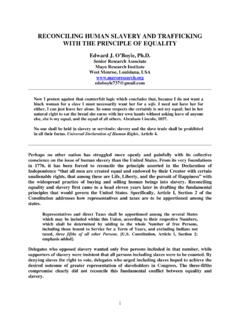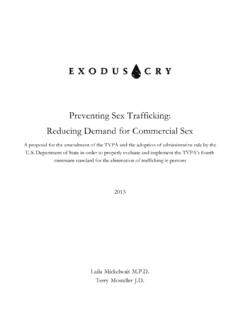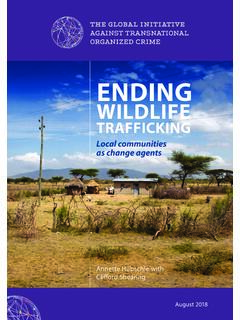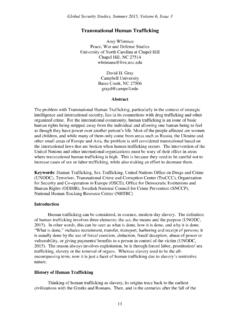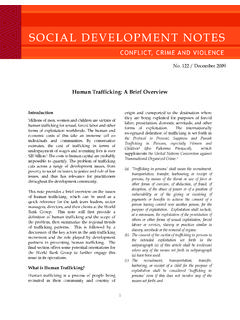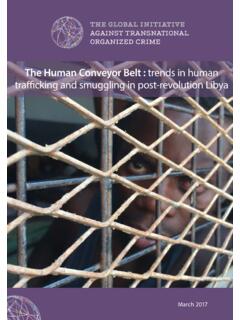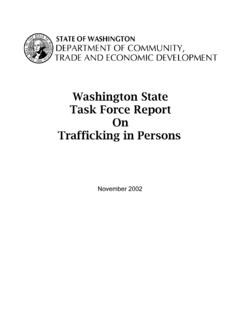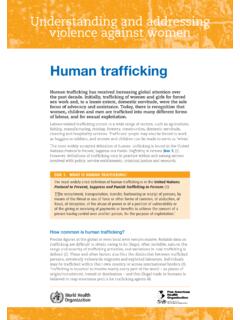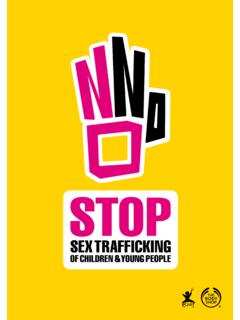Transcription of ILO ACTION AGAINST TRAFFICKING IN HUMAN BEINGS
1 CONTACT USInternational Labour ACTION Programme to CombatForced Programme onthe Elimination of Child LabourMigration ACTIONAGAINST TRAFFICKINGIN HUMAN BEINGSCONTENTI ntroduction: The labour dimensions of HUMAN trafficking11 Data collection32 Research and analysis53 ILO Conventions and national laws AGAINST HUMAN trafficking74 Enforcement of laws and regulations115 National and regional strategies136 Regulation and monitoring of the recruitment process157 Making migration safe178 Empowerment through employment, education and vocational training 219 Business AGAINST HUMAN trafficking2310 Trade union ACTION AGAINST HUMAN trafficking2511 Working with financial institutions2712 Gender mainstreaming in anti- TRAFFICKING programmes2913 HIV/AIDS and trafficking3114 Advocacy and global partnerships3315 Copyright International Labour Organization 2008 First published 2008 Publications of the International Labour Office enjoy copyright under Protocol 2 of the Universal CopyrightConvention.
2 Nevertheless, short excerpts from them may be reproduced without authorization, on condition that thesource is indicated. For rights of reproduction or translation, application should be made to ILO Publications (Rightsand Permissions), International Labour Office, CH-1211 Geneva 22, Switzerland, or by email: TheInternational Labour Office welcomes such , institutions and other users registered with reproduction rights organizations may make copies inaccordance with the licences issued to them for this purpose. Visit to find the reproduction rightsorganization in your ACTION AGAINST TRAFFICKING in HUMAN beings978-92-2-121007-8 (print) 978-92-2-121008-5 (web pdf)Geneva, 2008.
3 ILO Cataloguing in Publication DataThe designations employed in ILO publications, which are in conformity with United Nations practice, and thepresentation of material therein do not imply the expression of any opinion whatsoever on the part of theInternational Labour Office concerning the legal status of any country, area or territory or of its authorities, orconcerning the delimitation of its responsibility for opinions expressed in signed articles, studies and other contributions rests solely with theirauthors, and publication does not constitute an endorsement by the International Labour Office of the opinionsexpressed in them.
4 Reference to names of firms and commercial products and processes does not imply their endorsement by theInternational Labour Office, and any failure to mention a particular firm, commercial product or process is not a signof publications can be obtained through major booksellers or ILO local offices in many countries, or direct fromILO Publications, International Labour Office, CH-1211 Geneva 22, Switzerland. Catalogues or lists of newpublications are available free of charge from the above address, or by email: our website: in FranceSADP hotocomposed in SwitzerlandBIPAll over the world, and in increasingnumbers, people move. From their villageto the city.
5 From the city to the neighbour-ing country. Across continents in searchof a better life, a new beginning or justbecause circumstances dictate. Whilemany of them succeed, despite hard-ships, in finding new employment, someare coerced into work they have notchosen voluntarily. They have beendeceived about the nature of their work orconditions of their employment contract,they work under threat, are subjected toviolence, confined to their workplace ordo not receive the wage that was promised to them. They are victims of forced labour, andthey have been trafficked into a situation from which they find it difficult to , men and children are trafficked into a wide range of economic sectors and fordifferent purposes.
6 The TRAFFICKING of women and girls (and sometimes also boys) tocountries where demand for sexual services is high has long been recognized as a seriousproblem. Only recently, more attention has been paid to the TRAFFICKING and exploitation ofpersons in mainstream economic sectors. TRAFFICKING in persons has become a truly globalenterprise. It can involve legal as well as illegal activities. It is fuelled by criminal networks orindividuals seeking to exploit loopholes of national migration and labour market respond to the bottleneck of cheap and easily disposable labour in manycountries around the world. This is especially the case in industries that are labour intensiveand that rely on temporary work, such as agriculture, domestic work or take advantage of the huge supply of cheap labour, the ignorance of migrantworkers and the many constraints they have to to ILO estimates there are at least million trafficked persons at any given pointin time.
7 Yet there are only a few thousand convictions of traffickers every year. Most of thevictims are not identified and consequently never receive justice for the damage inflictedupon them. Despite growing awareness and more effective law enforcement responsestrafficking remains a low-risk criminal enterprise with high returns. The ILO estimates thatannual profits generated from TRAFFICKING in HUMAN BEINGS are as high as 32 billion USD. The ILO has addressed TRAFFICKING in HUMAN BEINGS early on in its history. While initial activi-ties were closely associated with the struggle AGAINST the white slave trade and the Leagueof Nations, it quickly received broader attention through the 1930 Convention AGAINST ForcedLabour.
8 The definition of forced labour contained in that Convention is still relevant today. The1 Introduction: The labour dimensions of HUMAN trafficking1 ILO s struggle AGAINST TRAFFICKING was furthermore reinforced by the adoption of two MigrantWorker s Conventions and the Worst Forms of Child Labour Convention. In its many projects and advocacy activities, the ILO addresses TRAFFICKING from a labourmarket perspective. It thereby seeks to eliminate the root causes, such as poverty, lack ofemployment and inefficient labour migration systems. ILO led responses involve labourmarket institutions, such as public employment services, labour inspectors and labourministries.
9 Moreover, as a tripartite organisation, the ILO consults and involves workers andemployers organisations in its work. It is also a partner to international organisations, suchas UNDP, IOM and UNICEF. This paper serves to outline ILO s major areas of intervention,some lessons learned and further references. 2 The ILO has developed the first-ever global estimate on the numbers of persons who areheld in forced labour, with a breakdown of those who have been trafficked into labour as wellas commercial sexual exploitation. Out of million forced labour victims worldwide,around million were trafficked. The figures present a conservative estimate of actualvictims at any given point in time, estimated over a period of ten years.
10 Earlier ILO estimates on child labour indicate that as many as million victims oftrafficking are minors (under 18). It is often assumed that people are mainly trafficked for thepurpose of commercial sexual exploitation. ILO estimates indicate, however, that 32% ofall victims were trafficked into labour exploitation, while 43% were trafficked for sexualexploitation and 25% for a mixture of both. Women and girls make up the overwhelmingmajority of those trafficked for the purpose of sexual exploitation (98%). International migrantworkers represent a large number of identified TRAFFICKING victims for labour exploitation andfor forced labour purposes.










